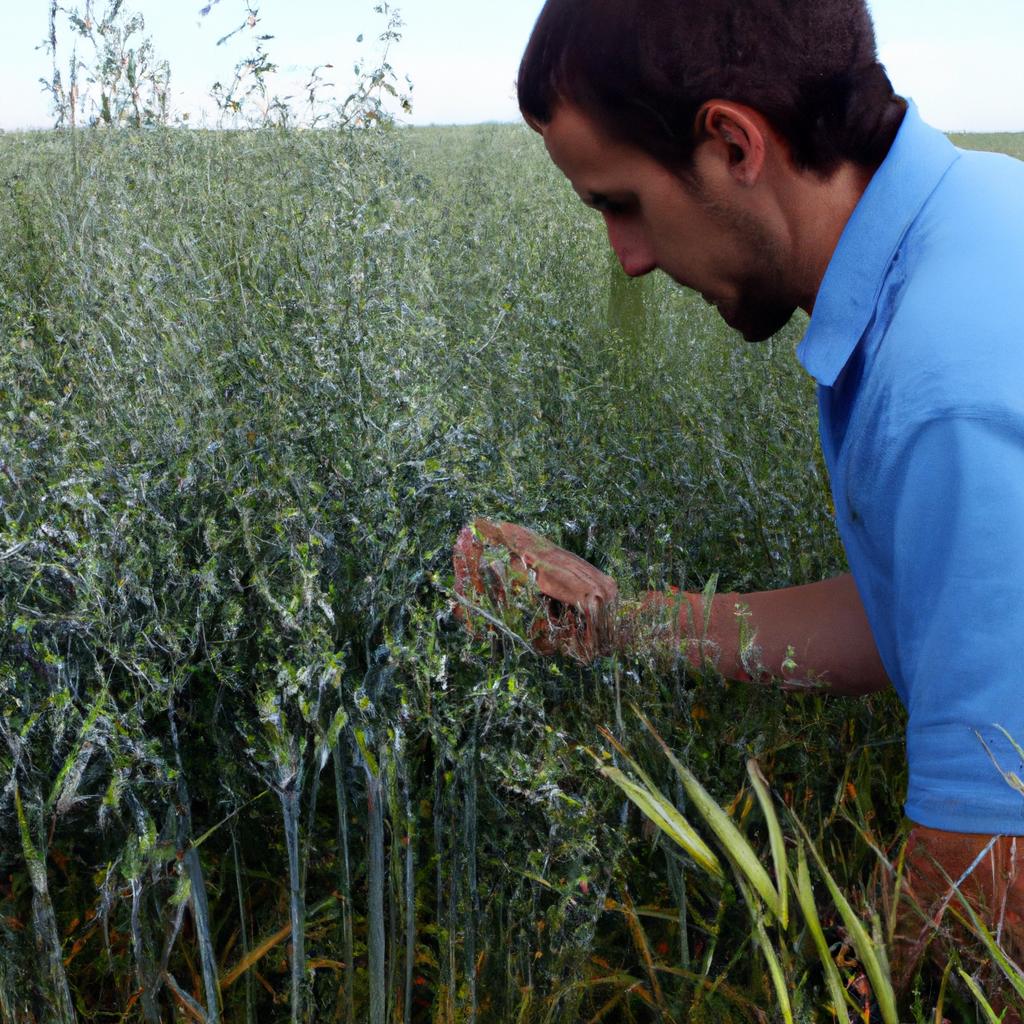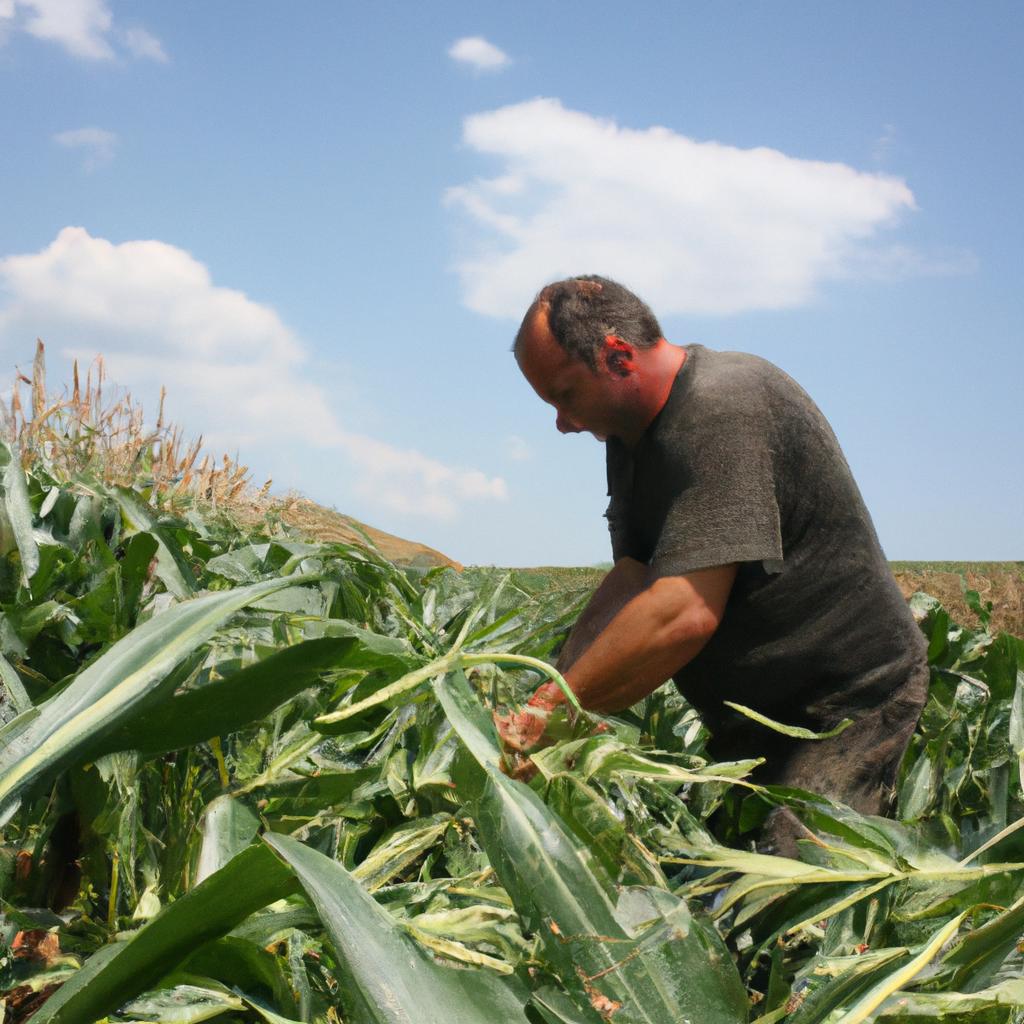Weed suppression is a critical aspect of maintaining the health and productivity of agricultural and forestry systems. In business agriculture and forestry, where profitability depends on maximizing crop yields, effective strategies for weed control are essential. One such strategy that has gained attention in recent years is crop rotation. By alternating different crops within a field over successive growing seasons, farmers can disrupt the life cycles of weeds and reduce their populations without relying heavily on herbicides or other chemical interventions.
For instance, consider a hypothetical scenario involving a soybean farmer who struggles with an infestation of common ragweed (Ambrosia artemisiifolia). This resilient weed competes aggressively with soybeans for nutrients, water, and sunlight, leading to reduced yields. The farmer decides to implement a three-year crop rotation plan by introducing winter wheat as the second crop in the cycle after soybeans. Winter wheat emerges earlier than ragweed in the spring, shading out its seedlings and preventing them from establishing strong growth. Additionally, winter wheat’s dense root system helps break up compacted soil layers, improving water infiltration and reducing conditions favorable for ragweed germination. Through this simple alteration of planting sequences, the farmer effectively suppresses ragweed populations while also benefiting from increased soil fertility due to nitrogen fixation by soybeans and improved weed control.
Crop rotation offers several benefits for weed suppression. Firstly, it disrupts the life cycle of weeds by introducing different crops that have varying growth habits and nutrient requirements. This can make it difficult for weeds to adapt and thrive consistently across multiple seasons. Secondly, certain crops in the rotation can outcompete weeds for resources such as sunlight, water, and nutrients, reducing their population density. Additionally, some crops may release allelopathic compounds that inhibit the growth of specific weed species.
In the example of the soybean farmer implementing a three-year crop rotation plan with winter wheat, the introduction of winter wheat helps suppress common ragweed populations through shading and competition. By emerging earlier in the spring than ragweed seedlings, winter wheat shades them out and prevents their establishment. The dense root system of winter wheat also improves soil structure and reduces compaction, making it less favorable for ragweed germination.
Furthermore, by incorporating nitrogen-fixing crops like soybeans into the rotation, farmers can improve soil fertility without relying heavily on synthetic fertilizers. This not only benefits crop growth but also contributes to weed suppression since healthier crops are often more competitive against weeds.
It is important to note that while crop rotation is an effective strategy for weed suppression, its success depends on careful planning and implementation. Farmers should consider factors such as crop compatibility, pest and disease management, market demands, and overall farm management goals when designing a crop rotation plan. Regular monitoring and adjustment may be necessary to optimize results over time.
Overall, crop rotation is a valuable tool in integrated weed management systems as it provides long-term sustainable solutions for weed control while maintaining soil health and maximizing yields in agricultural and forestry systems.
Importance of Weed Suppression
Importance of Weed Suppression
Crop rotation is a widely recognized practice in business agriculture and forestry that offers numerous benefits, particularly when it comes to weed suppression. By alternating different crops in a systematic manner within the same field over time, farmers can effectively combat weeds without relying heavily on herbicides or other chemical interventions. This section will explore the importance of weed suppression through crop rotation by examining its ecological advantages, economic implications, and potential for long-term sustainability.
To illustrate the significance of weed suppression, consider an example from a hypothetical farm. In this case study, Farmer Brown consistently rotates his crops each season between corn and soybeans. Through this strategic approach, he has successfully minimized weed growth while maintaining healthy yields for both crops. The absence of persistent weeds not only reduces competition for resources such as water, nutrients, and sunlight but also prevents them from acting as hosts for pests and diseases that could harm the crops. Consequently, by mitigating these threats through effective weed suppression techniques like crop rotation, farmers can enhance overall agricultural productivity.
The benefits of adopting crop rotation extend beyond ecological considerations; they have notable economic implications as well. For instance, by reducing reliance on herbicides and other costly chemical treatments typically used for weed control, farmers can significantly lower production costs. Moreover, since diverse crop rotations promote healthier soil conditions with improved nutrient availability and reduced erosion risks, there is likely to be less need for expensive fertilizers or soil amendments. These financial savings contribute positively to the profitability of farming operations while ensuring sustainable land management practices.
In addition to its environmental and economic advantages, crop rotation plays a vital role in achieving long-term sustainability in agriculture and forestry sectors. By diversifying planting patterns over successive seasons, farmers help break pest cycles specific to certain plant species while promoting biodiversity within their fields. Furthermore, incorporating cover crops into rotational schemes enhances soil health by reducing erosion risk during fallow periods and improving organic matter content over time—a key factor in preventing weed infestation. The use of crop rotation not only minimizes reliance on synthetic inputs but also fosters natural resilience within agroecosystems, making them more adaptable to changing climatic conditions and reducing the need for external interventions.
In light of these ecological, economic, and sustainability considerations, it is clear that weed suppression through crop rotation offers numerous advantages for business agriculture and forestry. In the subsequent section, we will explore different approaches to weed management that complement or enhance the effectiveness of crop rotation techniques. By understanding these varied strategies, farmers can develop comprehensive plans tailored to their specific needs while maximizing the benefits derived from this proactive approach to weed control.
Different Approaches to Weed Management
Benefits of Crop Rotation for Weed Suppression
Effective weed management is crucial in business agriculture and forestry to ensure optimal crop growth and productivity. In this section, we will explore the benefits of crop rotation as an approach to weed suppression. To illustrate these advantages, let us consider a hypothetical case study of a soybean farmer facing persistent weed infestation.
Case Study:
Imagine a soybean farmer who has been struggling with rampant weed growth in their fields. Despite employing various herbicides and manual labor, the weeds continue to thrive, competing with the soybeans for resources such as sunlight, water, and nutrients. This situation poses a significant threat to the farmer’s yield potential and economic sustainability.
Advantages of Crop Rotation:
-
Disrupting Weed Life Cycles: One key benefit of crop rotation in managing weeds is its ability to disrupt the life cycles of many common weeds. By alternating different crops across seasons or years, farmers can effectively break the cycle of specific weed species that are prone to recurring within monoculture systems. For instance, rotating soybeans with corn or wheat can help control broadleaf weeds like pigweed or lambsquarters which have similar life cycles but are susceptible to different herbicides.
-
Soil Nutrient Balance: Another advantage lies in maintaining soil nutrient balance through diversification. Different plant species have varying nutrient requirements and uptake patterns from the soil. When crops are rotated strategically, it helps prevent excessive depletion or accumulation of specific nutrients that certain weed species may rely on for growth. This disruption in nutrient availability limits their proliferation while promoting healthier crop growth and reducing competition.
-
Natural Biological Control: A diverse cropping system encourages natural biological control mechanisms against pests and weeds. Beneficial organisms like predatory insects or microorganisms play vital roles in suppressing pest populations by preying upon them or inhibiting their development stages during specific crop rotations. Additionally, some plants naturally release compounds into the soil that hinder weed germination or growth, further enhancing weed suppression efforts.
-
Enhanced Soil Structure: Crop rotation practices contribute to improved soil structure and reduced soil erosion risks. Different crops have varying root systems that penetrate the soil at different depths, which helps enhance its stability and water-holding capacity. This better soil structure facilitates increased infiltration of rainfall while minimizing surface runoff, preventing topsoil loss and reducing the establishment of certain weed species.
| Advantages of Crop Rotation for Weed Suppression |
|---|
| Disrupts weed life cycles |
| Maintains soil nutrient balance |
| Encourages natural biological control |
| Improves soil structure |
Considering the benefits discussed above, it becomes evident that crop rotation can be an effective approach for managing weeds in business agriculture and forestry. In the subsequent section, we will delve into another significant advantage of crop diversification – its positive impact on long-term sustainable farming practices.
Advantages of Crop Diversification
Weed Suppression in Business Agriculture and Forestry: The Benefits of Crop Rotation
Transition from Previous Section (H2: Different Approaches to Weed Management)
While various approaches can be employed to manage weeds in business agriculture and forestry, one particularly effective method is crop rotation. By alternately growing different crops in a given area over time, farmers can harness the power of diversification to suppress weed growth. In this section, we will explore the advantages of crop rotation as a strategy for weed management.
Advantages of Crop Rotation
Crop rotation offers several benefits that contribute to its efficacy in suppressing weeds. Firstly, it disrupts the life cycles of many common weed species by creating an environment where their preferred host plants are not consistently present. This interruption hinders the long-term survival and reproduction of these unwanted plants, reducing their overall impact on agricultural or forestry operations.
To illustrate this point, consider a hypothetical scenario involving two primary crops—corn and soybeans. Suppose a farmer continuously grows corn year after year without implementing any rotation practices. Over time, specific weed species that thrive in cornfields may become well-adapted and resilient, making them challenging to control effectively. However, if the farmer implements a rotational system alternating between corn and soybeans, they introduce variation into the landscape. As a result, certain weeds associated with corn cultivation face disruptions in their habitat availability during soybean-growing years.
Furthermore, crop diversity through rotation enhances soil health by preventing nutrient depletion and reducing pest pressure. When different crops are grown consecutively on the same land, each plant type has unique nutritional requirements and interacts differently with pests residing within the soil ecosystem. These variations help break pest life cycles while promoting balanced nutrient utilization throughout successive growing seasons.
The emotional response evoked by these benefits can be summarized as follows:
- Increased efficiency: Crop rotation reduces reliance on herbicides and other chemical interventions.
- Sustainable farming: Implementing crop rotation practices supports long-term environmental and ecological stability.
- Enhanced profitability: Effective weed suppression means higher crop yields, leading to improved financial outcomes for farmers.
- Improved food security: By managing weeds effectively, agricultural operations can ensure a more stable supply of food.
To further understand the advantages of crop rotation in suppressing weeds, let’s explore a comparative analysis using the following table:
| Crop Rotation Method | Weed Suppression Effectiveness | Environmental Impact | Cost |
|---|---|---|---|
| Continuous Monoculture (No Rotation) | Low | High (reliance on herbicides) | Moderate-High |
| Crop Rotation with Diverse Crops | High | Low-Moderate | Moderate |
As demonstrated by this comparison, implementing crop rotation methods that introduce diverse crops leads to greater effectiveness in weed suppression while mitigating negative environmental impacts. Additionally, such practices are economically viable as they reduce reliance on costly chemical interventions.
By embracing crop rotation as an integral part of their weed management strategies, businesses in agriculture and forestry can enjoy numerous benefits. These advantages extend beyond mere weed control and encompass enhanced soil health, increased efficiency, sustainable farming practices, improved profitability, and ultimately contribute to global food security efforts.
Transition to Next Section (H2: Enhancing Soil Health through Rotation)
Having explored the benefits of crop rotation in weed suppression within business agriculture and forestry sectors, we will now delve into how this practice contributes to enhancing soil health.
Enhancing Soil Health through Rotation
Crop diversification, also known as crop rotation, offers numerous benefits in business agriculture and forestry. By alternating crops on the same land over time, farmers and foresters can effectively suppress weeds while simultaneously promoting soil health and enhancing overall productivity. The advantages of crop diversification are evident through various case studies and research findings.
One noteworthy example is a study conducted by researchers at a large-scale agricultural operation in Iowa. They implemented a three-year crop rotation system consisting of corn, soybeans, and oats. The results demonstrated that incorporating oats into the rotation significantly reduced weed pressure compared to continuous corn or soybean cultivation. This reduction was attributed to the use of different herbicides for each crop and the disruption of weed life cycles through varying planting dates and management practices.
The benefits of crop diversification extend beyond weed suppression alone. Here are some key advantages associated with adopting diverse cropping systems:
- Enhanced nutrient cycling: Different crops have varied nutrient requirements. Through rotation, nutrients such as nitrogen, phosphorus, and potassium can be efficiently utilized from one growing season to another.
- Disease control: Rotating crops disrupts pest populations, reducing disease incidence and severity. Certain plants may even act as natural repellents against specific pests or pathogens.
- Improved soil structure: Each crop type interacts differently with the soil ecosystem. Rotation helps prevent compaction issues caused by repetitive tillage or machinery traffic.
- Increased biodiversity: A diverse range of crops attracts a wider array of beneficial organisms like pollinators and predators that help maintain ecological balance within agroecosystems.
By embracing these advantages, businesses engaged in agriculture and forestry can enhance their long-term sustainability while minimizing negative environmental impacts.
| Advantage | Description |
|---|---|
| Enhanced Nutrient Cycling | Efficient utilization of nutrients like nitrogen, phosphorus, and potassium across seasons |
| Disease Control | Disruption of pest populations, reducing disease incidence and severity |
| Improved Soil Structure | Prevention of compaction issues caused by repetitive tillage or machinery traffic |
| Increased Biodiversity | Attraction of beneficial organisms like pollinators and predators to maintain ecological balance |
Looking beyond immediate profits, adopting crop diversification practices promotes the resilience and longevity of agricultural and forestry enterprises. In the subsequent section on “Reducing Reliance on Herbicides,” we will explore how crop rotation can be leveraged as a strategy for sustainable weed management without solely relying on chemical interventions.
Reducing Reliance on Herbicides
Rotation is a fundamental practice in agriculture and forestry that involves alternating the cultivation of different crops or tree species in a specific area over time. This technique offers numerous benefits, particularly when it comes to weed suppression. By diversifying plant species and interrupting the life cycles of weeds, crop rotation can effectively reduce dependence on herbicides while enhancing soil health.
To illustrate the advantages of crop rotation, let us consider an example from business agriculture. A farmer who previously relied heavily on chemical herbicides decided to implement a rotational system involving corn, soybeans, and wheat. In the first year, corn was planted followed by soybeans in the second year and wheat in the third year. By rotating these crops annually, the farmer noticed a significant reduction in weed growth compared to previous years where monoculture practices were employed exclusively.
The following are some key points highlighting how crop rotation enhances soil health:
- Nutrient cycling: Different plants have varying nutrient requirements. Through crop rotation, farmers can optimize nutrient uptake by ensuring that each successive crop utilizes different nutrients from those previously depleted.
- Pest management: Certain pests and diseases tend to be specific to particular host plants. Rotating crops disrupts pest populations as they struggle to find suitable hosts continuously.
- Weed control: Crop rotation breaks the cycle of weeds that thrive under consistent conditions provided by monocultures. The introduction of different crops interrupts their life cycle and reduces their overall presence.
- Improved organic matter content: Diverse cropping systems contribute to increased organic matter content in soils due to varied root structures and decomposition rates.
Table 1 below demonstrates a hypothetical three-year rotational sequence for vegetables:
| Year | Crop |
|---|---|
| 1 | Tomatoes |
| 2 | Cabbage |
| 3 | Legumes |
This table showcases how different crops can be strategically rotated within a three-year cycle, effectively minimizing weed pressure and optimizing soil health.
Incorporating crop rotation into agriculture and forestry practices offers a sustainable approach to weed suppression. By thoughtfully planning rotational systems, farmers can reduce reliance on herbicides while promoting healthier soils. The next section will delve further into the economic benefits of crop rotation – increased yield and profitability in business agriculture and forestry operations.
Increased Yield and Profitability
By adopting crop rotation practices, businesses in agriculture and forestry can not only reduce their reliance on herbicides but also achieve increased yield and profitability. This section will explore the benefits of crop rotation for weed suppression.
Increased Yield and Profitability through Crop Rotation
Crop rotation offers several advantages that contribute to higher yields and improved profitability. A hypothetical example illustrates these benefits:
Imagine a business engaged in large-scale wheat production using conventional methods with regular herbicide applications. Facing persistent weed issues, they decide to implement a three-year crop rotation system. In the first year, they grow corn, followed by soybeans in the second year, and finally planting wheat again in the third year. Here are some key advantages observed:
-
Enhanced Nutrient Utilization: Different crops have varying nutrient requirements, allowing for more efficient use of fertilizers. For instance:
- Corn is known to be a heavy nitrogen user.
- Soybeans have symbiotic relationships with bacteria that fix atmospheric nitrogen.
- Wheat has different nutrient needs compared to both corn and soybeans.
-
Breakdown of Pest Cycles: Rotating crops disrupts pest life cycles by preventing them from establishing continuous food sources or habitats across multiple seasons.
-
Weed Suppression: Certain crops possess natural weed-suppressing qualities due to allelopathy (the release of chemicals inhibiting other plants’ growth). Incorporating such crops into rotations helps suppress weed populations effectively.
-
Soil Health Improvement: Diverse crop rotations increase soil organic matter content, enhance soil structure, improve water-holding capacity, and promote beneficial microbial activity—all critical factors contributing to overall plant health.
| Advantages of Crop Rotation | Examples |
|---|---|
| Enhanced nutrient utilization | Nitrogen-fixing soybeans and nitrogen-demanding corn |
| Breakdown of pest cycles | Disrupting the life cycle of pests by changing crops annually |
| Weed suppression | Allelopathic effects in certain crops reduce weed populations |
| Soil health improvement | Increased soil organic matter, improved structure, water retention, and beneficial microbes |
Incorporating crop rotation practices can lead to substantial benefits for businesses engaged in agriculture and forestry. By embracing diverse crop sequences instead of relying solely on herbicides, companies have a greater chance of achieving increased yields and profitability while simultaneously reducing negative environmental impacts.
By utilizing proper planning and employing scientifically proven methods like those discussed above, businesses can significantly enhance their long-term sustainability and contribute to a more productive agricultural landscape. Through wise management decisions such as implementing effective crop rotations, these enterprises play a vital role in fostering both economic growth and environmental stewardship.




